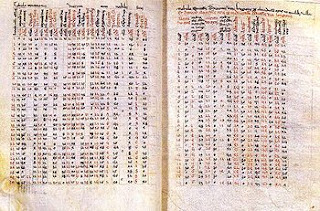 |
| Gemini. Spain, thirteenth century. |
It’s something of a tradition to begin or end biographies
of Alfonso X, el Sabio, with one
historian’s sanctimonious judgment of him: “While he contemplated the heavens
and gazed at the stars, he fell on the earth.” I quote it here not to
perpetuate misconceptions, but because the wording shows the importance of the
astronomy carried out in Alfonso X’s court. In spite of the
other fields of inquiry enhanced under the wise king’s patronage, it was
the astronomy that fascinated the most people first and longest.
Alfonso’s interest in the movement of the heavens was
based, as most of his passions, in pragmatism. In Alfonso’s time, astrology
hadn’t been separated from astronomy as a scientific discipline and was even
farther from being as discredited as it is today, as many fourteenth- and
fifteenth-century medical treatises (some of which refer to Alfonsine works)
attest. The king likely believed knowledge of the stars could be an important
tool in gaining the upper hand on Earth because of their obvious, albeit
mysterious, influence on human character and behavior.
That said, many of the Alfonsine astronomy books are based
on what is still considered solid science.
 |
| Alfonsine Tables. Spain, thirteenth century. |
The Alfonsine Tables are a set of measurements from about 1272 composed by Isaac ben
Sid and Judah ben Moses ha-Cohen that track the positions of the sun, moon, and
planets relative to Earth using Ptolemaic calculations. One of the astronomers
who worked on the Alfonsine Tables
took a copy with him in 1280 to Paris, where scholars adjusted the readings for
the Paris meridian, enabling astronomers all over northern Europe to make use
of the information for three hundred years. Copies survive today that were used
by Copernicus and Galileo. The practical applications of the Tables are what made them popular. They
well represented Alfonso X’s yearning for useful knowledge in the wider world.
 |
| The Alphonsus moon crater. Wikimedia Commons. |
Composed in the late 1270s, the most extensive book, the Book
of Knowledge of Astronomy, also had the largest team behind it. The
authors and translators named within the book include Jewish physicians, Muslim
lawmen, and Italian and Castilian churchmen. The Book of the Eighth Sphere, which makes up the first part, describes
the constellations with their celestial coordinates. The second part describes
how to make and use nine different kinds of astronomical instruments, such as
the astrolabe and the quadrant. Again, even in this most extensive and
encyclopedic work, useful is paramount.
The Book of the Fixed Stars was
translated from an Arabic book by Abd al-Rahman al Sufi composed around the
year 964. In this book, the Alfonsine collaborators created a powerful
combination of Ptolemy’s astronomy, Arabic traditions, and Castilian curiosity.
The Andromeda Galaxy and the Large Magellanic Cloud, among other landmark
bodies, were introduced to the European scientific community in this
translation.
 |
| Ursa Major from a 1490 English copy of the Alfonsine Tables. |
The astronomy works are exemplars of the admirable
Alfonsine traits of practicality and encyclopedism. The collaborators
translated and compiled information from the best and most reliable sources. The
majority draws from documents found in Arabic, with some information coming
into Castilian from far-flung languages such as Chaldean. Without the bridge
formed by these works, European astronomy might have had to start from scratch.
It’s much harder to see into the heavens if you’re not
standing on the shoulders of giants.
Jessica Knauss earned her PhD in medieval Spanish with a
dissertation on the portrayal of Alfonso X’s laws in the Cantigas de Santa Maria, which has been
published as the five-star-rated Law and Order in Medieval Spain. Look for her book of stories based on the Cantigas, coming 2021. A driven fiction
writer, Jessica Knauss has edited many fine historical novels and is a
bilingual freelance editor. Her historical epic, Seven Noble Knights, is available from Encircle Publications in ebook, paperback, and hardcover. Her
contemporary paranormal Awash in Talent is now available from Kindle Press. Find out more about her
writing and bookish activities here. Follow her on Facebook and Twitter, too!
